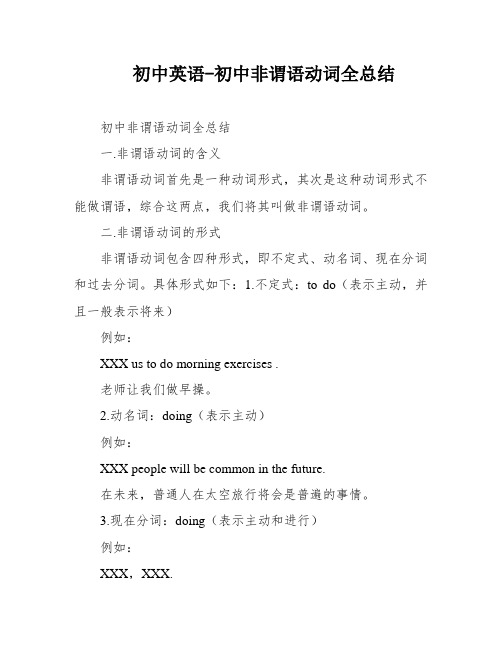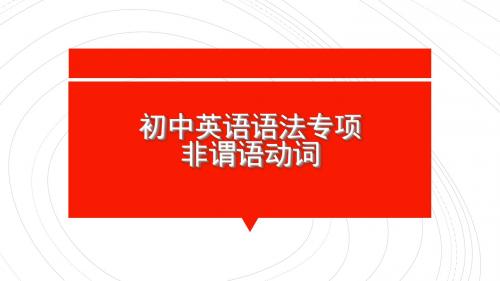初中英语语法系列非谓语动词
初中英语语法非谓语动词

It is good of you to help me with my English. 你真好,帮助我学英语。 (强调you的特征=You are good to help me.) It is good for you to give up smoking. 戒烟对你有好处。 (强调的是give up smoking这一行为= For you to give up smoking is good.)
F、作定语(必须后置)
I have something to say . It’s the best way to help him .
1、had better 后 2、使让动词 make , let , have 用于主动语态时。 3、感官动词see, hear , watch , feel , notice 用在 “经常”的主动语态时。
Looking at a crowded street Listening to my own heart beat So many people all around the world Tell me where do I find someone like you girl Take me to your heart take me to your soul Give me your hand before I’m old Show me what love is - haven’t got a clue Show me that wonders can be true They say nothing lasts forever We’re only here today Love is now or never Bring me far away Take me to your heart take me to your soul Give me your hand and hold me Show me what love is - be my guiding star It’s easy take me to your heart Standing on a mountain high Looking at the moon through a clear blue sky I should go and see some friends But they don’t really comprehend Don’t need too much talking without saying anything All I need is someone who makes me wanna sing
初中英语语法公式非谓语动词

初中英语语法公式非谓语动词
非谓语动词是指在句子中不表示谓语关系,可作主语、宾语、定语、
状语等的动词形式。
在初中英语语法中,常见的非谓语动词有动词不定式、动名词和分词。
1.动词不定式
a. 主动形式:to + 动词原形(to do)
b. 被动形式:to be + 动词过去分词(to be done)
c. 完成形式:to have + 动词过去分词(to have done)
2.动名词
动名词的形式为动词 + -ing(doing)
3.分词
a. 现在分词:动词原形 + -ing(doing)
b. 过去分词:动词过去式或不规则过去分词形式(done)
非谓语动词在句子中具有以下用法:
1. 作主语:To travel is his dream.(不定式)
2. 作宾语:I like swimming.(动名词) / She wants to join
the club.(不定式)
3. 作定语:The book on the table is mine.(现在分词) / The girl with a red hat is my friend.(分词)。
初中英语语法之非谓语动词

初中英语语法之非谓语动词1.定义:动词除在句子中作谓语以外,还具有名词、形容词及副词的性质,在句中可作主语、表语、宾语、定语、状语和补语等,这就是动词的非谓语动词。
可分为三种:动词不定式、分词和动名词。
2.动词不定式:to + 动词原形。
1)一般式:主动语态:to do ,被动语态:to be + 动词过去分词2)进行式:主动语态:to be doing ,被动语态:无3)完成式:主动语态:to have +动词过去分词,被动语态:to have been +动词过去分词4)用法:A. 作主语:To learn a foreign language is not easy . = It’s not easy to learn a foreign language .B. 作表语:The most important thing is to finish the workon time .C. 作宾语:a. 动词+to do . He decided to buy a new watch .b. 动词+疑问词+to do I don’t k now where to put thebike .c. 动词+形式宾语+宾补+to do I find it important to learna second foreign language .D. 作补语:a. 动词+宾语+to do Tom asked me to show him the new shoes .b. 动词+宾语+不带to的动词He often saw Tom play football .E. 作状语:a. 表示目的:He went to Guangzhou to see his sons . He got up early in order to catch the first bus .b. 表示结果:He is too tired to walk any farther . They aren’t old enough to go to school .c. 表示原因:He is sorry to hear that . I am glad to see you .F.作定语:I have something to tell you . I want to buy something to eat .5)动词不定式to 的省略:A. 在感官动词feel,hear,see,watch,notice 及使役动词have,let,make等后面要省to,但在变被动语态时要还原不定式to.I often saw him go out of the room .——He was often seen to go out of the room by me .B.在had better,would rather,do nothing but等后面常省to.6)动词不定式的否定形式:not + to do ,有时也可以用-never + to do 结构。
初中英语语法讲解——非谓语动词

初中英语语法讲解——非谓语动词非谓语动词在句子中充当除谓语以外的句子成分的动词形式叫做非谓语动词。
非谓语动词分为三种形式:不定式,动名词,和分词(分词包括现在分词和过去分词)。
1)不定式a. 有些动词可以用动名词作宾语。
例如:2. worth 的用法worth, worthy, worthwhile都是形容词,意为"值得"。
1) worth:be worth + n.当名词为金钱时,表示"…… 值得……"常见的有It ’s worth while to do./ It ’s worth(someone’s)while doingbe worth doing sth."……某事值得被做"The question is not worth discussing again and again. 这问题不值得反复讨论。
2) worthy:be worthy of +n.当名词为抽象名词时表示"……值得……"be worthy to be done "某事值得被做"The question is not worthy to be discussed again and again.3) worthwhile:be worthwhile to do sth"值得做某事"It is worthwhile to ask him to join the club.值得邀请他加入俱乐部。
典型例题It is not ____ to discuss the question again and again.A. worthB. worthyC. worthwhileD. worth while答案C. 由worth的用法可知,此句只适合词组be worthwhile to do sth.。
选C。
动词不定式动词不定式由to+动词原形构成。
初中英语语法系列第七讲非谓语动词

Benson非谓语动词概述在句子中充当除谓语动词以外的句子成分的动词形式叫做非谓语动词。
非谓语动词包括不定式(to do),动名词(-ing),现在分词(-ing),过去分词(-ed)。
他们不受主语人称和数的限制,在句子中不能充当谓语动词,但是可以充当句子的其他成分,并且有时态和语态的变化,所以要正确使用非谓语形式,一定要理解不同形式所表现的意义,要明确非谓语动词与逻辑主语之间是“主动”还是“被动”关系,所表示的动作是“过去”,“现在”,还是“将来”,以及和谓语动词所表现的动作是同步发生还是有先后之分。
不定式一、不定式的句法功能1.不定式做主语To see is to believe眼见为实BensonTo work means to earn a living工作就是为了谋生Tip:不定式做主语,太长的时候,通常用形式主语it来代替。
It is impossible for us to live without clean water.没有干净的水,我们是不可能生存的(it来代替to live without clean water)2.不定式做宾语We need to take measures to prevent people from damaging environment.我们应该采取措施阻止人们破坏环境I want to watch TV.我想看电视3.不定式做表语(说明主语的内容、性质、特征)主语通常是表意向、打算、计划的词,如:wish,idea,task,purpose,duty,dream,aim 等,常用to do 不定式做表语My dream is to be a teacher.我的梦想是成为一名老师My duty is to take good care of my little sister.我的责任就是照顾我的妹妹4.不定式做定语(后置定语,来修饰名词)常见不定式做后置定语的词:way,ability,chance,time,place,the first,the second,the only,the last 等I have a lot of homework to do .我有许多作业要做He is the first to come and the last to leave.Benson他是第一个来的,最后一个走的She has enough money to buy a computer.她有足够的钱买一台电脑5.不定式做宾补(V+sb to do sth)My mother tells me to do my homework first.我的妈妈告诉我要先做作业He invited us to go for a picnic last weekend.上周末他邀请我们去野餐6.不定式做状语(状语是用来修饰动词的)(1)做目的状语I come here to tell you that I have finished doing my homework. 我来是为了告诉你我的作业已经写完了(to tell you...做目的状语)He bought a bag of food to eat他买了一包食物吃(to eat 做目的状语)(2)做结果状语He got to the station,only to find the train has already left .他到达车站,发现火车已经离开了(火车离开是结果状语)He is too young to go to school.他太小了而不能上学(不能去上学是结果)(3)原因状语I am sorry to hear that you lost your wallet.听说你的钱包丢了我很难过(难过的原因是钱包丢了)They were excited to hear the news.Benson他们听到这个消息很激动(激动的原因是听到了消息)二、接不定式作宾语的动词(V+to do sth)afford(支付得起),agree(同意),aks(要求)choose(选择),continue(继续),decide(决定)dare(敢于),expect(期望),fail(失败)help(帮助),hope(希望),learn(学),like(喜欢)manage(成功),offer(提供)plan(计划)prepare(准备),promise(承诺),prefer(更喜欢)refuse(拒绝),want(想要),wish(希望)三、接不定式作宾补的动词(V+sb to do sth)tell,ask,want,wish,warn,teach,expect,encourage,allow,advise,remind,require,request, permit,persuade,order,need,leave,invite,hate,force,command,beg等四、不带to的动词不定式(1)感官动词hear,see,watch,notice,feel等后跟不带to的不定式感官动词+sb+do sth表示:动作的全过程感官动词+sb+doing sth表示:动作正在进行(2)使役动词make,let,have(使,让)+ sb do sth 让某人做某事。
中学英语非谓语动词讲解

中学英语非谓语动词讲解非谓语动词是指动词的非时态形式,它包括不定式、动名词和分词(包括现在分词和过去分词)。
非谓语动词可以作主语、宾语、表语、定语、状语等成分,具有多种语法功能和句法结构。
在中学英语中,非谓语动词被广泛使用,掌握非谓语动词的用法对于学生的语言表达能力和阅读理解能力提升非常重要。
一、不定式(Infinitives)1. 不定式作主语:- To learn a foreign language is beneficial to your future.- It's important to exercise regularly.2. 不定式作宾语:- I want to go shopping after school.- He promised to finish the report by tomorrow.3. 不定式作表语:- Her dream is to become a doctor.- The most important thing is to believe in yourself.4. 不定式作定语:- She has a lot of books to read during the summer vacation.- This is a good place to have a picnic.5. 不定式作状语:- I wake up early to catch the bus.- She studied hard to pass the exam.二、动名词(Gerunds)1. 动名词作主语:- Swimming is my favorite sport.- Dancing helps improve coordination.2. 动名词作宾语:- She enjoys reading novels.- He hates doing the dishes.3. 动名词作表语:- His hobby is playing the piano.- The key to success is working hard.4. 动名词作定语:- I have a meeting with my boss tomorrow morning. - The running water sounds relaxing.5. 动名词作状语:- She left the room, crying loudly.- He drove to work, listening to music.三、分词(Participles)1. 现在分词作定语:- The exciting movie kept us on the edge of our seats. - The running boy bumped into a lady.2. 现在分词作状语:- Smiling happily, she accepted the gift.- With his homework finished, he went to bed.3. 过去分词作定语:- The broken chair needs to be repaired.- The lost dog was found by its owner.4. 过去分词作状语:- Inspired by her teacher, she decided to pursue a career in art.- Exhausted from the long journey, they went straight to bed.总结起来,中学英语非谓语动词的用法主要包括不定式、动名词和分词。
初中英语知识归纳总结——非谓语动词

初中英语知识归纳总结——非谓语动词非谓语动词(一)教学重点动词不定式在英语中,不充当句子谓语的动词,叫作非谓语动词。
由于非谓语动词不受主语的限制,没有时态和语态,所以又叫非限定动词。
非限定动词有三种形式:动词不定式;动名词和分词。
1、动词不定式(1)动词不定式的构成和性质动词不定式是一种非谓语动词,所谓非谓语动词就是不能作谓语的动词。
正因为如此,它不受主语的人称和数的限制,没有人称和数的变化,但它具有动词的某些特征,可以带宾语和状语构成不定式短语。
其构成是:“to + 动词原形”,否定式是“not to +动词原形”。
to是不定式符号,无词义。
(2)动词不定式的用法动词不定式除了不能作谓语外,可以作主语、表语、宾语、宾语补足语、定语和状语。
①作主语To learn English well is not easy.To drive fast is quite dangerous.不定式作主语时常常用it作形式主语,不定式放在谓语之后以上两个例句可以写成:It is not easy to learn English well.It is quite dangerous to drive fast.这种用法可以归纳成这样一个句型:It is (not) + 形容词+ (for sb.) to do sth.It is very expensive for me to buy a car.It is very difficult for a child to do that job.有些形容词之后跟of + 名词(代词宾语)+不定式。
如:It is very kind of you to say so.It is very good of you to come.②作表语。
如:My job is to teach English.The first thing is to ring him up.③作宾语。
初中英语语法系列---非谓语动词ppt课件

been doing 完成进行式 to have ___________ ______________
(过去已开始,还在进行)
动词不定式的句法功能
一:作主语
To learn English well is not easy.
但是,为了避免头重脚轻,常用“ it ”作形式主语, 吧真正的主语(动词不定式短语)放到后面。
It’s very kind of you to help me. 你能帮我,真好。 It’s clever of you to work out the maths problem. 你真聪明,解出了这道数学题。
It is + adj.+ for sb.+ to do sth.
possible等。
后面只能接不定式作宾语的动词有:
三个希望两答应
两个要求莫拒绝 设法学会做决定 不要假装在选择 提供帮助的计划
hope,wish,want,agree,promise
ask,demand,refuse manage,learn,decide pretend,choose offer,help,plan
基本形式:to+动词原形
各种形式: 主动 被动
to be done ______________
to do 一般式(未发生) ___________
be doing 进行式(正进行) to ___________
______________ been done 完成式(已发生) to ____________ ______________ have done to have
特殊短语: would rather + do had better + do
初中英语-初中非谓语动词全总结

初中英语-初中非谓语动词全总结初中非谓语动词全总结一.非谓语动词的含义非谓语动词首先是一种动词形式,其次是这种动词形式不能做谓语,综合这两点,我们将其叫做非谓语动词。
二.非谓语动词的形式非谓语动词包含四种形式,即不定式、动名词、现在分词和过去分词。
具体形式如下:1.不定式:to do(表示主动,并且一般表示将来)例如:XXX us to do morning exercises .老师让我们做早操。
2.动名词:doing(表示主动)例如:XXX people will be common in the future.在未来,普通人在太空旅行将会是普遍的事情。
3.现在分词:doing(表示主动和进行)例如:XXX,XXX.他坐在那边,读着一张报纸。
4.曩昔分词:done及物动词的过去分词表示被动或完成;不及物动词的过去分词表示主动或完成。
polluted river被污染的河流(及物动词pollute和river之间是被动关系,即“河流被污染”)XXX落叶(不及物动词fall和leaves之间是主动关系,即“叶子落下来”)注意:非谓语动词本身不能表示现在和过去。
非谓语动词表示进行和将来是相对于谓语动作来说的:和谓语动作同时发生表示进行;发生在谓语动作之后表示将来三.非谓语动词的作用非谓语动词除去不克不及做谓语以外,其它一切身分都能够做。
详细如下。
1.不定式:做主语、宾语、表语、定语、状语和补语。
To learn a foreign language is difficult .(作主语)学会一门外语是很难的。
It’s easy to see their aunt.(作真正主语,it做形式主语)很容易见到他们的姑姑。
Tom wanted to have a cup of beer.(作宾语)XXX想要喝杯啤酒。
His wish is to be a driver.(作表语)他的愿望是当一名司机。
I have nothing to say.(作定语)我没有什么可说的。
初中英语语法课件:非谓语动词 (共51张PPT)

be used to doing习惯于...
【山东•泰安】 3.—How about going shopping this weekend, Peter? —Sorry. I prefer ______ rather than ______. A. to stay at home, go out B. to go out, stay at home C. staying at home, go out D. going out, stay at home
not doing not done
2)介词后+doing
vi+介词+n, vt+n.
be used to, prevent......from, depend on,feel like, put off, give up, help yourself to, be busy (in),have difficulty(in) doing, prefer doing to doing
the river 6. Where is Bill? He promised _____(be) here on time 7.I’m not in a hurry. I don’t mind _____(wait) 8. What have you decided _____(do) 9.George was very angry and refused _____(speak) to me 10. I’ve put off _____(write) the letter so many times. I
—Sorry. I prefer ______ rather than ______.
A. to stay at home, go out B. to go out, stay at home
初中英语知识点归纳非谓语动词的分类与用法

初中英语知识点归纳非谓语动词的分类与用法初中英语知识点归纳:非谓语动词的分类与用法非谓语动词是指不能作谓语的动词形式,包括动词不定式(infinitive)、动名词(gerund)和现在分词(present participle)等形式。
在英语语法中,非谓语动词作为名词、形容词或副词的补语,经常出现在句子中起到修饰或补充说明的作用。
下面将对非谓语动词的分类和用法进行归纳总结。
一、动词不定式(infinitive)1. 主动形式的动词不定式作主语、宾语、表语等。
示例:- To swim in the sea is my favorite activity.(在海里游泳是我最喜欢的活动。
)- I want to be a doctor.(我想成为一名医生。
)2. 不定式的被动形式常常用于被动语态、感官动词和某些特定的动词后作宾语。
示例:- The book is easy to understand.(这本书很容易理解。
)- I heard him singing in the shower.(我听见他在淋浴时唱歌。
)3. 不定式的完成形式表示在谓语动词之前发生的动作。
示例:- I'm happy to have finished my homework.(我很高兴已经完成了作业。
)二、动名词(gerund)1. 动名词作主语,常用于表示习惯、通用事实、抽象概念等。
示例:- Swimming is good for your health.(游泳对健康有益。
)2. 动名词作宾语,常与动词一起构成一些固定搭配。
示例:- I enjoy playing basketball with my friends.(我喜欢和朋友们打篮球。
)3. 动名词作介词的宾语,常用于介词后。
示例:- He is good at singing.(他擅长唱歌。
)三、现在分词(present participle)1. 现在分词作定语,修饰名词或代词。
初中英语语法大全——非谓语动词(共21张PPT)

6. 作状语 动词不定式短语作状语,可表示目的结果原因、条件和 方式等。 动词不定式短语作目的状语时,不定式短语可放在句子 的前面,也可放在句子的末尾。在句子前面时,不定式 常与句子用逗号隔开;在句子末尾时,一般不用逗号隔开。 To get there on time, we set out at five in the morning. He goes there to enjoy the fresh air.
动名词(doing)
1.作主语
动名词作主语-般表示经常性、习惯性的动作,有时也用 it 作形式主语,而把动名词后置。动名词常常被看作是 不可数名词,作主语时,谓语用第三人称单数形式。 Taking a cold shower every morning does him good. Learning English all by yourself not so easy. Working in these conditions is not a pleasure.
3. 作宾语 动词不定式短语作宾语,放在及物动词之后作动词的宾 语。如: I can't afford to buy a car.我买不起汽车。 Remember to post the letter.记住把信寄了。 I hope to be saying with you.我希望和你住在一起。
4.作定语 动词不定式短语作定语,放在它所修饰的名词之后。如: I have a letter to answer.我有一封信要回复。 Liu Ying was the girl to meet you.刘英就是来接你的 那个女孩子。 I have some clothes to wash.我有些衣服要洗。 I have a wish to go to college.我有一个上大学的愿望。
初中英语语法-非谓语动词

初中英语语法-⾮谓语动词⾮谓语动词⼀.定义:⾮谓语动词是指在句⼦中不是谓语的动词,即动词的⾮谓语形式。
约占中考10%。
⼆.分类:动词不定式、v-ing形式和过去分词。
1.动词不定式1)构成:(not) to do / (not) do2)句法功能:(1)作主语:To finish the work in ten minutes is very hard. ⼗分钟之内完成这项⼯作是很难的。
To lose your heart means failure. 灰⼼意味着失败。
动词不定式短语作主语时,常⽤it作形式主语,真正的主语不定式置于句后,例如上⾯两句可⽤如下形式:It is very hard to finish the work in ten minutes. ⼗分钟之内完成这项⼯作是很难的。
It means failure to lose your heart. 灰⼼意味着失败。
常⽤句式:It+be+名词+to do sth.It takes sb.+some time+to do sth.It+be+形容词+of /forsb +to do sth.常⽤careless, clever, good, foolish, honest, kind, lazy, nice, right, silly, stupid, wise,等表⽰赞扬或批评的形容词,不定式前的sb.可作其逻辑主语。
区别:当使⽤for时,句中形容词修饰的是不定式;It’s necessary for you to study hard .(necessary 修饰to study hard,表⽰学习努⼒是有必要的)⽽⽤of时,句中形容词修饰逻辑主语。
It’s fo olish of him to do it .(foolish 修饰逻辑主语him)(2)作表语:Her job is to clean the hall. 她的⼯作是打扫⼤厅。
初中英语语法非谓语动词

初中英语语法非谓语动词非谓语动词非谓语动词在句zhil中不能作谓语。
非谓语动词是中考考点之一,主要考查动词不定式和动词-ing形式。
动词不定式考点一:作宾语。
1.后跟动词不定式(短语)作宾语的动词(短语)有agree, afford, ask, choose, decide, expect, fail, fear, help, hope, learn, manage, offer, plan, prefer, prepare, promise, refuse, want, wish, try one' s best 等。
2.“疑问词+动词不定式”在句中可以作宾语。
【考例链接】单项选择()1.—Please stay with me this weekend.—r m sorry, but my father and I planned Beijing a long time ago.A.visitvisitingB.to visitvisited()2.In his e-mail, David promised his daughter during her stay in Japan.A.visitingvisitB.visitedto visit考点二:动词不定式的否认结构由not+动词不定式构成。
考点三:作宾语补足语。
1.一些动词后常跟动词不定式(短语)作宾语补足语,这类动词有allow, advise, ask, call, encourage, expect, force, get, help, invite, need, order, remind, teach, tell, train, want, warn 等。
2.使役动词(如make, let, have等)及感官动词(如see, feel, hear, watch, notice等)后跟动词不定式(短语)作宾语补足语时须省略to,但在变为被动语态时要加上tOo 注意:make sb. done表示“使某人被……”。
初中英语语法专项非谓语动词

选择题
A 1.The house is not big enough for us all_______. A. to live in B. to be lived in C. to live D. for living in A 2. Would you please pass me the knife _______?
I haven't decided whether to go or stay.
下列词接动名词和不定式均可,但意义不 同的动词:
stop to do 停下来去做 forget to do 忘记要做 remember to do 记得要做 regret to do 遗憾要做 try to do 企图做,尽力做 stop doing 停止做 forget doing 忘记做过 remember doing 记得做过 regret doing 后悔做过 try doing 试着做
4、被动式to be done 例如:The work is to be done soon. 5、完成被动式to have been done 例如:The boy is said to have been sent to hospital yesterday.
二. 动词不定式的用法
What caused him _to__ change his mind?
这些动词后常接宾语补足语
advise, allow, ask, beg, cause, expect, encourage, force, get, invite , order, wish , want, warn, remind, promise, permit, persuade(劝说), request+sb. to do
初中英语语法大全——非谓语动词(共24张PPT)

知识归纳 常用it作形式主语的句式 It is no use/ good doing..做...是没有用的不好的。 It is a waste of time doing...做..是浪费时间的。 It is useful/ enjoyable/ tiring doing...
做...是有用的/ 令人高兴的/累人的
(6)不定式作状语
①不定式作状语主要表示目的等。表示目的时常位于句首,表 示原因和结果时常位于句尾。 eg: To arrive there on time, I got up one hour earlier than usual. eg: In ancient China, food was stored with ice to kee p it fresh.
常接动名词作宾语的(短语)动词
enjoy喜欢
finish完成
practise练习
suggest建议
mind介意
avoid避免
admit承认
consider考虑
give up放弃
look forward to盼望
imagine想象
be busy忙于 put off推迟
feel like想要
be worth值得
(4)不定式作宾语补足语
eg: Lucy asked him to turn down the radio. eg: Mr. White persuaded Tom not to smoke any more. eg: I sat near her and heard her sing the new song. eg: The peaceful music in the CD made the students feel relax.
初中英语语法非谓语动词

初中英语语法——非谓语动词非谓语动词指的是在句中起名词,形容词或副词作用的动词形式,而不是作谓语的动词形式。
动词的非谓语形式分为动名词,分词,动词不定式。
Climbing mountain is a good exercise. (Climbing..., 动名词起名词作用)Do you know the man wearing a white shirt? (wearing ..分词起形容词作用)He gets up early to catch the first bus. (to catch ...不定式起副词作用)谓语动词和非谓语动词的区别:1) 谓语动词在句中可单独作谓语,而非谓语动词不能单独作谓语。
Miss Mary teaches us English. 玛丽教我们英语。
(teaches 动词作谓语)Mr. Li came to our classroom to have a talk with us last week.(to have a talk.... 不定式作状语)2) 谓语动词受主语的人称和数的限制,而非谓语动词形式没有这种限制。
Mike likes the pop music. (动词用单数第三人称形式)Lucy has nothing to do today。
(do 用原形)动词不定式:1. 动词不定式作主语:To master a language is not an easy thing.To teach English is my favorite.It's my pleasure to help you.动词不定式作主语时可以放在后面,而用it 作形式主语放在原主语的位置上。
It's very kind of you to have given us much help.你给了我们那么多的帮助真是太好了。
It's necessary to find the witness. 有必要找到目击者。
- 1、下载文档前请自行甄别文档内容的完整性,平台不提供额外的编辑、内容补充、找答案等附加服务。
- 2、"仅部分预览"的文档,不可在线预览部分如存在完整性等问题,可反馈申请退款(可完整预览的文档不适用该条件!)。
- 3、如文档侵犯您的权益,请联系客服反馈,我们会尽快为您处理(人工客服工作时间:9:00-18:30)。
(2) 动词后的宾补,需要省
略不定式符号to的动词:
一感 feel 二听 hear,listen to 三使 make,let,have
The boy made the baby cry. 四看 notice,observe,see,watch I saw him
不定式的常考点:
5、不定式的特殊句型:
1)too…to…:太…而不能… He is too excited to speak. 2)enough to do:足以做 … The child is old enough to go to school. 3) " Why not +动词原形"表达向某人提出建议,翻译为:
Good afternoon!
一. 总述 二. 分类 三.不定式的用法 四.动名词的用法 五.分词的用法
还记得,动词第一讲时: 我们将动词按形式,划分为两类
动 词
谓语动词
谓语动词就是能在句子中作谓语的动词(独立
做谓语,或者构成复合谓语皆可)
非谓语动词
谓语动词就是不能在句子中作谓语的动词
非 谓 语 动 词
பைடு நூலகம்
动词不定式的句法功能
二:作表语
动词不定式(短语)常用于系动词be的后面作表语。
His work is to drive a car.
My job is to feed animals.
动词不定式的句法功能
三:作宾语
动词不定式(短语)可以放在一些动 词后面作宾语。
这些动词很关键!
在一些动词的后面,只允许接 不定式作宾语:
后面只能接不定式作宾语的动词有:
三个希望两答应 hope,wish,want,agree,promise 两个要求莫拒绝 ask,demand,refuse 设法学会做决定 manage,learn,decide 不要假装在选择 pretend,choose 提供帮助的计划 offer,help,plan 预期失败要发生 expect,fail,happen 看似都接不定式 seem
动词不定式 动名词
非谓语动词的特点:
1. 由动词构成 2. 在句子中不做谓语
现在分词
废
分词
话
过去分词
动词不定式
基本形式:to+动词原形 (有时可以不带to ) 。 ●动词不定式没有人称和数的变化 ●在句子中不能作谓语 ●但可以担任除谓语外的任何成分——主 语、表语、宾语、状语和宾语补足语。
动词不定式的各种形式
五:不定式作定语
the food to live __o_n___ the bus to come here _o_n__ the pen to write _w__it_h_ the room to live __in__ the knife to cut _w__it_h_
the person to write a_b_o_u_t
不定式的常考点:
1. “to” 是不定式符号还是介词,下列短语中的to 都是
介词。 agree to,object to,close to , come to , lead to ,
refer to ,equal to , familiar to , point to , thank to ,
devote to , next to , belong to ,
答案:B. tell sb to do sth 的否定形式为tell sb not to do sth.
4、动词不定式与疑问词连用:疑问代词who, what, which和疑问副词 when, where, how , why等后面可以
按动词不定式,构成动词不定式短语,可以在句子中作主语、宾 语、表语等成分。 例如: (1) He doesn’t know how to use the machine. (不定式作宾语) (2) How to use the machine is a question. (不定式作主语) (3) The question is when to go there. (不定式作表语)
基本形式:to+动词原形
各种形式:
主动
被动
一般式(未发生) __t_o__d__o____ _to__b_e__d_o_n__e____
进行式(正进行) t_o__b_e__d_o__in__g ______________
完成式(已发生) to__h_a_v_e__d_o_n__e_to h_a_v__e_b_e_e__n_d__o_n_e
不定式作定语的基本条件 不定式与它所修饰的名词在逻 辑上必须具备以下条件之一:
1. 主谓关系 2. 动(介)宾关系 3. 说明所修饰词的内容
多为抽象名词或序数词
分析下列句子
He is the right person to do it. 主谓
He has a lot of work to do. 动宾
It’s the best way to learn English.
说明内容
五:不定式作状语
1.表原因(原因状语): 2.I’m sorry to trouble you.
2.表目的(目的状语): I went to the library to learn English.
动词不定式
表将 来
四:不定式作宾语补足语
1)不可省略to的: 2)可省略to的: 3)可以省可以不省的:
(1)动词后的宾补,不可以 省略不定式符号to的:
tell / ask / want / would like / wish / like / invite / encourage / teach + sb. to do sth.
play football on the playground yesterday. # 注意:变为被动语态时,不定式短语从宾语补足语变 为主语补足语,to还要重现到动词原形前。 例:The boy made the baby cry. (主动语态省略to) The baby was made to cry by the boy. (被动语态: 宾补变主补,to 要加回来)
be(get) used to 习惯于,
look forward to 渴望,
pay attention to 注意,
get down to
开始认真(做某事),
devote oneself to 献身于
2. 带to 还是不带to
I have no choice but to give in.
I cannot do anything but give in.
表目的
表某一次具体的动作
1.表示将来: I have a lot of work to do.
2.表示某一次具体的动作: I like dancing, but I don’t like to dance
today.
3. 表示目的: To learn English well, you must practise
完成进行式 to h_a_v_e__b_e__e_n__doin_g_____________
(过去已开始,还在进行)
动词不定式的句法功能
一:作主语
To learn English well is not easy.
但是,为了避免头重脚轻,常用“ it ”作形式主语, 吧真正的主语(动词不定式短语)放到后面。
It’s very kind of you to help me. 你能帮我,真好。 It’s clever of you to work out the maths problem. 你真聪明,解出了这道数学题。
It is + adj.+ for sb.+ to do sth.
与 for 连用的形容词常常用来形容“物”:
"为什么不……?" Why not take a holiday? 4)so as (not) to do: 表示目的 Go in quietly so as not to wake the baby.
动名词
动词的-ing形式用作动名词:
● 由动词原形加-ing构成 ● 它在句中起名词的作用 ● 可以在句子中用作主语、表语、宾语、 宾语补语、状语和定语。
动名词的句法功能
• 3) 动名词作宾语 Jim dislikes eating chocolate. 吉姆不喜欢 吃巧克力。 She can’t help crying at a sad movie. 她 看了忧伤的电影禁不住要哭。
more.
先看几个例句,判断不定式在句中的成分。
1.To learn a foreign language is difficult . 2. His wish is to be a driver . 3.Tom wanted to have a cup of beer . 4.The teacher told us to do morning exercises . 5.I have nothing to say . 6.They went to see their aunt . 7.It’s easy to see their aunt. 8.I don’t know what to do next . 9.I heard them make a noise .
动名词
动名词的特点:
① 抽象 ② 习惯性
His hobby is painting.
习惯 I’m proud of being a Chinese.
抽象
• Learning English is very difficult . 学英语非常困难。
